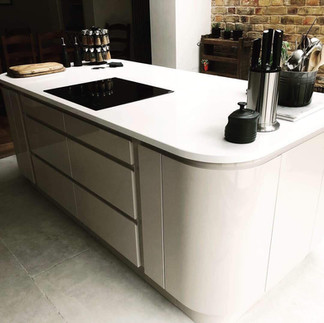What's the Best Material for Kitchen
- Vladimir Castravet

- Oct 6, 2022
- 3 min read
Updated: Oct 12, 2022
1. Solid wood

Wood is by far the most common material used for cabinets. It is a non-toxic and renewable resource. You can then stain and varnish the surface or paint it with your choice of hue.
Wood is available in a diverse range of grains, colours and textures. Natural variation within the material itself adds to its distinctive appeal. It adapts very well to both traditional and modern design styles. Avoid highly acidic solutions, such as commercial cleaners.
'Wood doors are strong and durable, and scratches or dents can be repaired with a little sanding and a coat of matching stain. Stained wood doors are a great choice for homeowners wanting a classic-looking kitchen using a traditional design that shows off both the beauty and the sturdiness of hardwood doors.'
Strength and durability: Especially when treated, wood kitchen cabinets can last for years.
Environmentally friendly and more sustainable: Anyone looking to make their kitchen more eco-friendly should opt for a responsibly sourced solid wood for their kitchen cabinets. As long as it’s produced in a sustainable way, solid wood is better for the environment that manufactured materials.
Available in many styles: Solid wood kitchen cabinets can be made using lots of different types of wood. Some of the most popular include oak, walnut, cherry, and maple, each of which offer various tones which can completely change the style of a kitchen. Not only are there different woods to choose from, but it’s also possible to paint or treat the wood in a way that still showcases its natural textures.
2. Laminates

As solid wood is prone to damage and infestation, often laminates are preferred. Laminates are thin sheets sandwiched together – layers of plastic resin, paper with a printed layer of different patterns or designs, and an overlay of a tough plastic film.
Laminates are thin sheets sandwiched together – layers of plastic resin, several layers of kraft paper topped with a printed layer of different patterns or designs, and an overlay of a tough plastic film.
Laminate kitchens are more durable, moisture-resistant and sturdy than the LPLs (low-pressure laminates). From matte to high-gloss, and unicore (where every layer of paper in the laminate has the same pattern and colour, so there is no wearing away) to digital (with specialised, even customised, printing on the surface), you have a lot to choose from.
These compressed sheets are both durable and affordable. Since the printed layer comes on a paper backing, you can achieve the look of almost all materials (like wood, metal, leather) with laminates. Its skin does not wear off, scratch or fade easily and it does not require repeated polishing. Laminates are quite resistant to moisture and cleaning their surface is much simpler because they are coated with a thin transparent plastic layer.
3. Wood veneers

Veneers are slices or sheets of solid wood that are pasted over a composite substrate, just like laminates. These sheets are then stained and polished to achieve a desired colour and texture. Veneers truthfully reflect the refined grains and beauty of natural wood.
Wood veneers are sustainable and economical compared to wood as only thin slices of solid wood are used to cover large surface areas. Veneers can make a potentially hard-edged kitchen look softer. Veneers can be treated to achieve matte, semi-gloss and high-gloss finishes.
4. MDF Kitchen Cabinets

MDF-Medium Density Fiberboard, is one of the most popular kitchen cabinet materials to go for as it's easy on the budget yet available in a variety of styles and finishes. It's easy to clean and will last you a fair amount of time. It's similar to plywood in that it is a manufactured wood product made up of wood fibers bound with resin and compressed into panels.
MDF is more dense than hardwood and gives a smoother finish with no grain, making it ideal if you are painting kitchen cabinet doors yourself, to get a professional look.
Due to its density and consistent structure, MDF can be machined using high-speed CNC cutting tools to create a variety of different 3-D profiles perfect for cabinet doors.
Varying size options: MDF is easy to cut into different sizes, making it ideal for awkward-shaped, or extra-large kitchen cabinets. It has a flat, even surface: Being man-made, MDF panels are made perfectly smooth and even. The flat surface means it’s easy to apply laminate or even wood veneer onto the panels. It also means that paint can be applied to achieve a neat and attractive cabinet.
Projects
if you interested please contact us on: info@4architectjoinery.co.uk






























Comments